Australia Day, 26th January, flying our traditional Australian Flag, the mandatory long weekend public holiday fully paid, mandatory speaking English, whatever it’s Aussie time!
Australia Day January 26 is so rock solid historically cemented in the cultural psyche of Australians that it deserves extending into being a full-blown Australia Week! (Jan 26 to 31).
‘Singing tooral liooral liaddity‘ nationwide let’s have an Australia Week of festivity. Don’t risk those illicit Chinese drugs. Just instead enjoy Aussie lamb on the Barbie with good cold Aussie beers or wine.
Australians Historically Get Real
Here’s an Australian History lesson maties as you deservedly relax on the Day.
Many Australians are being classroom are being censored from understanding our own proud colonial past by anti-Australian leftist globalist types like the Australian Education Union and foreign ‘players’. Many are ignorant about the difference between Cooks landing at Botany Bay in 1770, and Arthur Phillip’s First Fleet landing in 1788 eighteen years later. They have no idea about Cook’s Australia possession declaration on behalf of the British Empire up in the Torres Strait.
Ignorant anti-Australian Lefties keep vandalising Cook monuments as if he had something to do with 1788. Cook was murdered a decade prior on February 4 1779 by Hawaiian savages in Kealakekua Bay.
Australians young and old alike would do well on our national day to reflect upon and learn the historical truths, warts and all.
Take pride in our nation, it’s still best on the planet, just. Dismiss all the leftist negativity and vandalistic hate invariably trotted out by anti-Australian revisionists this time of year. Ignore their mistruths, their imagined fictions and fantasies fabricating divisive White guilt tripping.
Aussies get real and be comfortable in your skin.
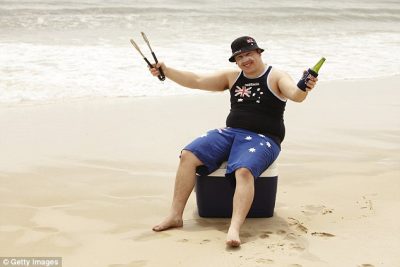
“Not menshioning Botany Bay”
British Lieutenant Cook Discovered Australia
 Historically, Cook was White and he just did it.
Historically, Cook was White and he just did it.
Cook didn’t exactly follow British aristorcratic dogma. His orders to find our continent were secret after all.
But then Cook’s initiative set a trend which has culturally stuck down under.
The simple truth is that thanks to James Cook, the British took possession and colonised Australia before the French got a chance.
Third World Aborigines were never going to continue blissfully subsisting, once First World Europe evolved into its Age of Enlightenment which inspired its Age of Discovery.
The umbrella term is ‘Western Civilisation‘. The age mindset drove a race for discovery and conquest of the Third World. And the lesson of history is that might is right.
Back in Australia’s conception date of 1788, the then globally unknown continent sustained an estimated 750,000 natives divided into 500 odd tribes. They were primal and ‘acephalous‘ lot – hunter-gathering, bush-tuckering and else squatting in humpies without any central leadership. Generally this subsistence is termed Third World.
Eighteenth Century colonisation of the continental natives/savages by the superior First World states of Europe was arguably inevitable around Cook’s time. These primal acephalous societies spears were no watch against British firepower. Comparably, the Britons had suffered the fate of the Norman Conquest in 1066 – being similarly blissfully ignorant, unprepared, outnumbered, and outgunned. In history, might was right.
Australians these days are in a similar conquest predicament should the imperialist mighty wealthy and militarist Chinese keep getting their way.
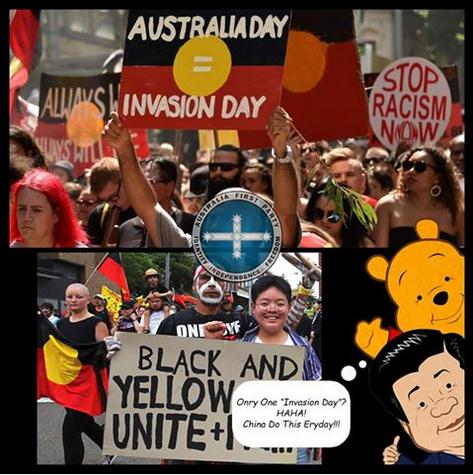
“Progress, far from consisting in change, depends on retentiveness. When change is absolute there remains no being to improve and no direction is set for possible improvement: and when experience is not retained, as among savages, infancy is perpetual. Those who cannot remember the past are condemned to repeat it.” – a universally acknowledged quote from Spanish philosopher George Santayana (1863-1952).
Aborigines could well now be speaking French, or perhaps Dutch, had it not been for the British possession by explorer James Cook, and followed through by Arthur Phillip’s convict settlement leadership. James Cook had later edited his journal upon arrival in Batavia (Jakarta) after discovering the great south land, when he was confronted with the news that the Frenchman, Louis Bougainville, had sailed across the Pacific the previous year. In his revised journal entry, Cook wrote that he had claimed the entire east coast (later naming the region New South Wales) for the British Crown.
Historically, Australians ought to be thankful for Cook’s journal entry providing critical evidence that he on behalf of the British Admiralty had beaten the French to claim the continent.
The 500 Aboriginal tribe descendants of our now Australian nation should well learn their past warts and all and recognise that history is history. Bad things historically happened, evil things happened inflicted by both sides but that was generations ago. The culture shock and guilt belongs to prior generations.
Aboriginal and White Australians alike today could well be speaking Japanese if the Americans hadn’t help us win the battle of the Coral Sea and then nuked the ego out of imperialist Emperor Hirohito. Would America have helped defend Australia from the invading Japs if we’d been a French colony? Probably not.
Yet historical ‘what ifs’ are irrelevant constructed fantasies, generally by the unAustralian Left desiring some MDMA dreamt One World globalist-communist notion of utopia.
For tomorrow, all Australia celebrates the birth of our nation at Sydney Cove on January 26 in 1788. It was not from ‘terra nullius’ (nobody’s land) but certainly ‘terra primum acephalum‘ (primal headless land). to a First World civilised nation in just 113 years by 1901, from a terra which over a century colonisation and civilisation by the British first fleet
before the French did – change the day and make it a whole week of festivity
Change Australia Day to being a whole week of Aussie flag waving, and take time out to learn the historical truth warts and all
Australia’s First Landing
On April 29 in 1770, then British Lieutenant James Cook was the first of this First World state power to discover the south-east coast of the down under continent since called Australia, landing in Botany Bay. It had been postulated as the Terra Australis Incognita – the unknown southern land, hence down under.
The British Red Ensign was the first ever flag to fly on this continent on this day by Cook unofficially as a symbolic gesture of taking possession of the continent in the name of King George III.
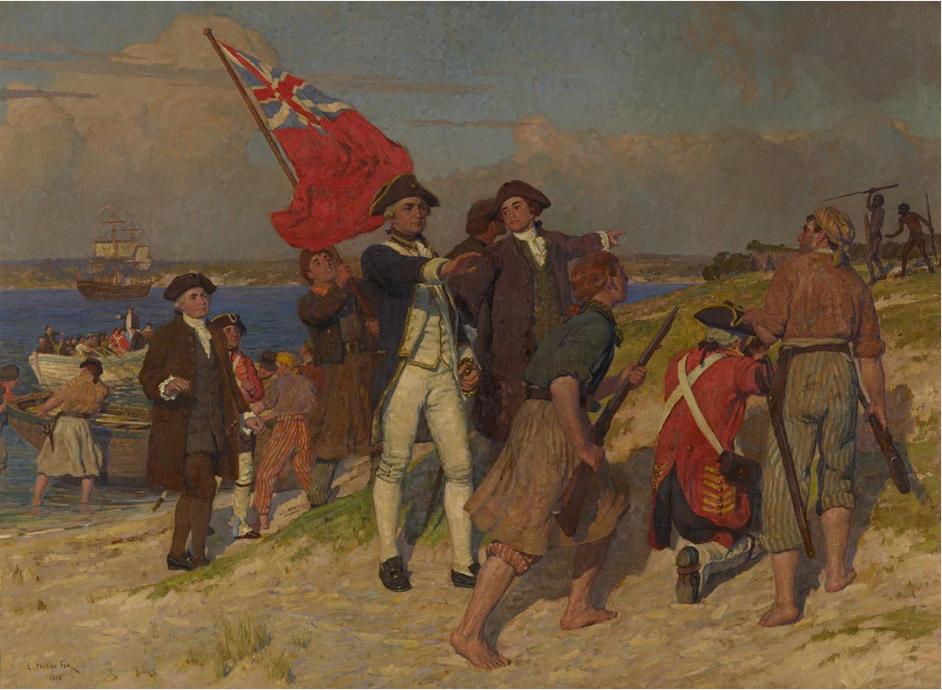
This 1902 oil on canvas painting (192.2 × 265.4 cm) by Australian painter Emanuel Phillips Fox is entitled ‘Landing of Captain Cook at Botany Bay, 1770‘. Contrary to other interpretative illustration, it correctly depicts the British Red Ensign (1707–1801) being flown ashore.
The flag raised ashore at Botany is a red field with the Union Flag of Great Britain in the canton (top hoist corner). Union Flag of ‘the King’s Colours’ dates to 1606 and at Cook’s time it was the ensign armorial of Great Britain to be used on ships on the high seas. The British Red Ensign (1707–1801)Thirty years subsequent with the creation of the United Kingdom of Great Britain and Ireland, Ireland’s then Saint Patrick’s red cross flag was incorporated into to the flag of Great Britain to create the present-day Union Flag.
The above painting was commissioned in 1900 by the National Gallery of Victoria thanks to a generous bequest from the late William Gillbee (1825-1885) who had been a prominent and wealthy senior surgeon at the Melbourne Hospital. The ‘Gillbee Bequest of £1000 was for an artist to paint depictions of exemplary Australian history.
Fox painted ‘Landing of Captain Cook at Botany Bay, 1770‘, and another painter John Longstaff painted ‘Arrival of Burke, Wills and King at the deserted camp at Cooper’s Creek, Sunday evening, 21st April 1861′.
The artistic so-called ‘Aboriginal flag’ didn’t appear until over two hundred years into White Australia, when Aborigine Harold Thomas painted his red, gold and black abstract painting in 1971 while benefiting from a White taxpayer scholarship at the South Australian School of Art.
 John Longstaff’s oil painting of 1907 depicting ‘The Arrival of Burke and Wills at Cooper’s Creek 1861‘ so entitled.
John Longstaff’s oil painting of 1907 depicting ‘The Arrival of Burke and Wills at Cooper’s Creek 1861‘ so entitled.
A student of Australian History would be well-informed about Burke and Wills’ epic inland expedition of 1861 to search for dreams of an inland sea in outback Australia. Similarly, a student of Australia History would have learned of how the two explorers had tragically perished due to starvation and chronic loss of vitamin B1 at the drought ravaged Coopers Creek.
Such students of Australia History would be well inspired also reading that their expedition companion John King was sustained by the goodwill of the local Yantruwanta people as ‘one of their own’ for months before Alfred Howitt’s rescue party arrived in September 1861.
History is not black and white.
British Lieutenant Cook Took Possession
Almost 1800 nautical miles north of Cook’s Botany Bay landing, after running aground on a coral reef, on 22 August 1770 at around midday Cook’s ship sailed around the northernmost tip of this now discovered continent’s east coast.
Without leaving the ship, Cook named the tip Cape York, then turned westward, nursing his battered ship through the dangerously shallow waters of Torres Strait. Dutch explorer Luis Váez de Torres had been there in 1606, so Australia could have become Dutch.
Searching for a high vantage point, Cook saw a steep hill on a nearby island from the top of which he hoped to see “a passage into the Indian Seas” westward. Cook climbed the hill with two crew and Joseph Banks. On seeing a navigable passage, he signalled the good news down to the men on the ship, who cheered loudly.
Cook later wrote that he had claimed possession of the east coast when up on that hill, and named the place ‘Possession Island’. Why not? That was his instructions, and there are no records of natives running around on the island.
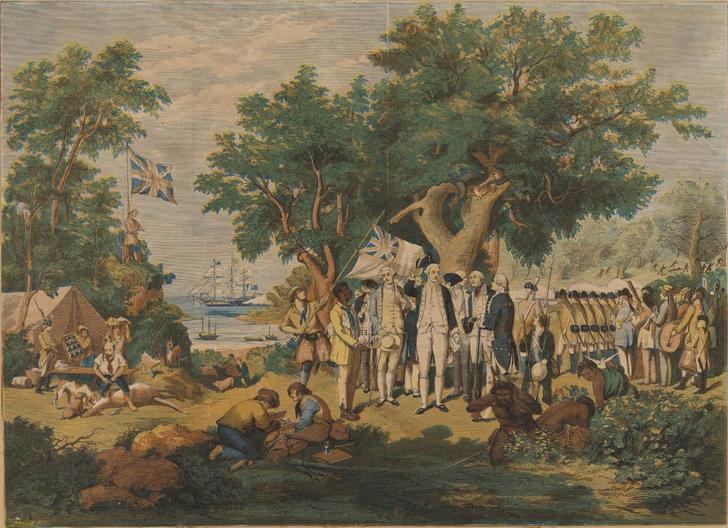
‘Captain Cook taking possession of New South Wales‘ painted by John Alexander Gilfillan in 1910.
Cook here on now ‘Possession Island at the top of Queensland, Cook is show with a variant flag of Great Britain, the flag of the Cross of St George with the flag of Great Britain in the canton. Here Cook was not a mariner explorer, but assuming the role of territorial possessor on behalf of the British Admiralty. In the background is the Union Flag of Great Britain.
British Admiral Phillip Founded Australia
Some eighteen years after Cook’s discovery, landing and declared possession of the ‘great south land’, British naval Admiral Arthur Phillip commanded the First Fleet of eleven convict ships from Great Britain to return to Cook’s discovered continent at Botany Bay.
As if the passengers in irons had a choice?
After his appointment in 1787 as governor of a penal colony in a country that was then without a name, he wrote down what he insisted should be its first law: “There can be no slavery in a free land.” This was 20 years before slavery was abolished in Britain and a century before international law made it a crime.
Phillip refused to sail until the fleet was properly provisioned and he kept the convicts alive over their eight-month voyage by ordering that they have fresh fruit to ward off scurvy and daily exercise to maintain health. By a stroke of luck, he had served valiantly when loaned to the Portuguese navy and was welcomed as a hero when the fleet put in at Rio — with the result that it was provided with the fresh food and oranges needed for the rest of the voyage.
Phillip soon settled in nearby Port Jackson at a fresh water stream at what became named Sydney Cove. Significantly to Australia Day the date was January 26 in 1788. Phillip became the first Governor of New South Wales, a penal colony. So began the birth of the Australian nation, and the rest as they say is history.
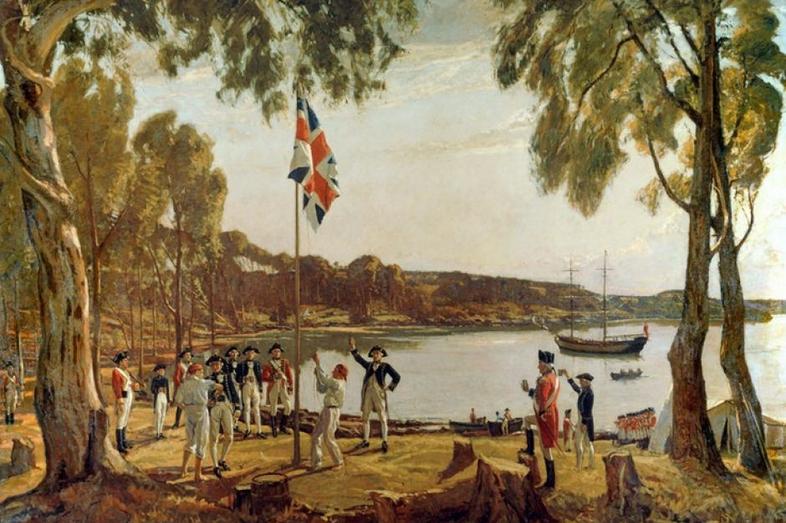
‘The Founding of Australia. By Capt. Arthur Phillip R.N. Sydney Cove, Jan. 26th‘ – an oil sketch by painter Algernon Talmage of the British Royal Academy of Arts in 1937. [Oil on Canvas, 226 × 319 cm]. Here Phillip has the Union Flag of Great Britain raised.
On the lead up to Australia Day January 26, anti-Australian leftist extremist keep picking on mythical ‘Captain Cook’. Cook was never a captain. As a British Naval Officer James Cook discovered Australia in the commissioned rank of Lieutenant. Upon return to Britain after his first voyage of discovery in 1771, Cook was duly recognised and promoted to the naval rank of Commander.
The First Fleet’s First Week
Although Cook had landed at Botany Bay in 1770 and had suggested this as a site for settlement, Phillip on January 18 in 1788 with his eleven ships in the First Fleet reached Botany Bay. Phillip spent several days examining the bay but found no freshwater in order to sustain a settlement.
Writes Australian Historian, Dr Ann Moyal AM of Australian national University:
‘So (Phillip) set out with several officers on Monday 21 January 1788, travelling by cutter twenty miles north to enter Port Jackson (named but not visited by Cook). There, in early afternoon, they were astonished to find ‘the finest harbour in the world’, in which, wrote Phillip, ‘a thousand sail of the line may ride in the most perfect security’. Examining the many bays that studded the harbour, Phillip settled for one he would name ‘Sydney Cove’ which possessed a freshwater spring of water at its head flowing into the cove, and was positioned where the ships could anchor close to the shore.
After two more days examining the harbour landscape, Phillip returned to Botany Bay and led his Fleet into Sydney Harbour aboard the Supply on Friday 25 January. By nightfall the eleven ships, the entire First Fleet, was safely assembled at Port Jackson.
(Wrote Captain Watkin Tench on the transport sailing ship Friendship:
“Having passed between the capes which form its entrance, we found ourselves in a port superior, in extent and excellency, to all we had seen before. We continued to run up the harbor about four miles, in a westerly direction, enjoying the luxuriant prospect of its shores, covered with trees to the water’s edge, among which many of the Indians [Aborigines] were frequently seen, till we arrived at a small snug cove on the southern side, on whose banks the plan of our operations was destined to commence”.
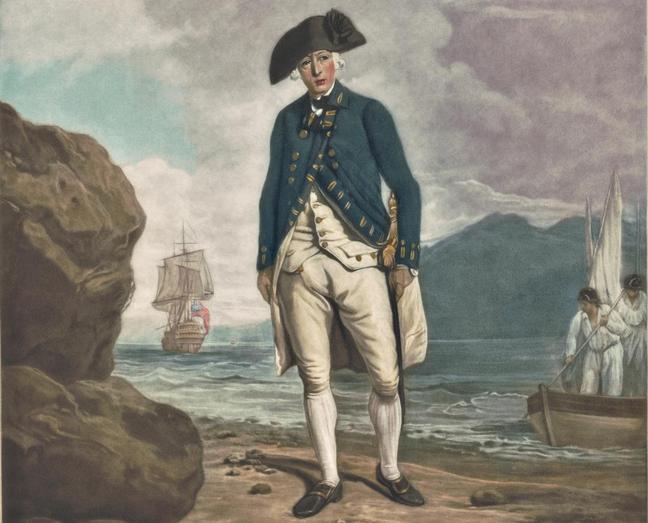
Francis Wheatley’s ‘Captain Arthur Phillip, 1786‘ – an oil on canvas portrait [30 x 25cm] in 1786 of then Royal Navy Captain Arthur Phillip.
On the morning of Saturday, 26th January, the colours were displayed, the British (Union) flag (of Great Britain) flown, and possession of the country taken formally in the name of King George III. ‘At sun-set’, George Worgan, surgeon aboard the Sirius, reported, ‘the Governor, the principal officers of the settlement, and many of the private soldiers, drank His Majesty’s health & success to the new colony’.
No convict, however, set foot on Australian land that day and, it should be recorded in light of the historical importance attached to 26 January as a commemorative national date, that, neither the large company of male convicts destined to develop the colony, nor any women or children were present at the inaugural ceremony on that landmark day.

..The first week on land was packed with action. On 27 January, sailors from the Sirius, together with a body of marines and a number of male convicts were landed at Sydney Cove to fell timber and clear the ground, the once quiet scene humming with the sounds of falling timber and the erecting of tents. The remaining large company of male convicts was disembarked from the transports over the following days. ‘Confusion quickly gave way to system’, Tench observed. Phillip himself structured the ordering of the camp. His own tent as Governor and those of his attendant staff, the Officer of the Commissary, Lieutenant George Johnston; his aide-de-camp, Lieutenant Arthur Miller, and his personal servant, Henry Dodd, were set on the east side of the Cadigal stream (the spring of water named by the local tribe and known subsequently as the Tank Stream) and the tents of the male convicts on the west. He at once ensured that the trees and bush were left uncut on both sides of the stream providing nine metres of undergrowth and greenery and requiring that the stream at all times be kept free of debris.
On 29 January 1788, Phillip attempted to communicate with the local people. According to a young officer, William Bradley (1757?–1833), the local people invited the newcomers to join them in dancing together with much laughter and friendliness. Bradley later captured this scene in a series of drawings.
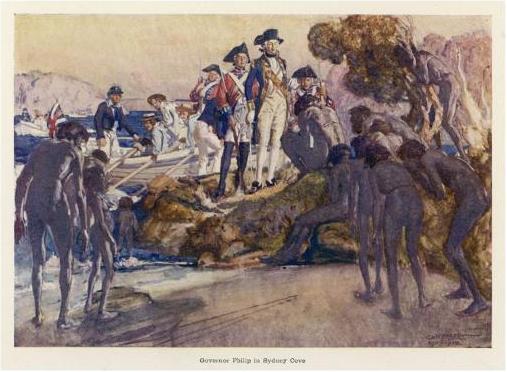 ‘Governor Phillip in Sydney Cove‘ an oil on canvas painting circa 1913 (53 x 37cm) by George Washington Lambert (1873-1930).
‘Governor Phillip in Sydney Cove‘ an oil on canvas painting circa 1913 (53 x 37cm) by George Washington Lambert (1873-1930).
For many weeks the landed party camped in tents and marquees (ten male convicts to a tent) and high priority was given to building strong permanent storehouses for the settlement’s provisions. In this new country they sat under roofs of rough thatch.
The Governor’s imported portable house was placed in position on 29 January and on the 30th the transports’ long boats landed the livestock – one bull, five cows, one bull calf, one stallion, three mares, three colts, and a number of ewes and hogs and goats from the Cape of Good Hope – on the eastern point of the cove. A ragged shack serving as the hospital, with separate spaces for convicts and soldiers, was also laid out within days on the western side. ‘Every detail, no matter how large and small’, one observer noted, ‘passed under Phillip’s watchful eye’.”
So the whole week of Australia;s Founding deserves a week of celebration annually.
Phillip navigated 11 ships to the other side of the world, where he determinedly met the challenge of establishing a new society in an unknown country. From the moment he stepped ashore at Botany Bay, Phillip’s character, vision, persistence and life experience enabled him to make the fledgling colony viable. And that’s no small feat for the man so often relegated to the first line of Australia’s history.
Royal Navy Admiral and Governor Arthur Phillip (1738-1814) was White Australia’s founding father. At Port Jackson, his practicality, his optimism and his courage kept the settlement going in its first desperate years. At one point, to the horror of his marines, he even shared his own rations with the convicts — an unheard-of act of egalitarianism.
For all the ills that later befell them, Phillip’s treatment of Aborigines was kindly and well-meaning. What he showed in his actions, and recognised in theirs, was a common bond of humanity.
Invasion Day Lefties are just anti-Australian Ignorant
But Cook had nothing to do with 1788 and Australia Day. The anti-Australian persecution and hateful vandalism of Cook’s statue in Sydney by so-called Invasion Day activists are criminal acts by historically ignorant Leftards.

Change the date of Australia Day to Australia Week, and thank God for Cook beating the French in discovering Australia, else we’d all be speaking French. Consequently without America in WWII, else speaking bloody Japanese.

Greens-Left teams up with Socialist Alliance and assorted antifa communist ferals hatefully seeking to divide society and exercise their overzealous presumptive paternalism over Aborigines. Invasion Day lefties are just ignorant anti-Australian.
If they’re happy to be ao anti-Australian, the Australian govermnent should deny them Australian walfare payments. They are all welcome to mirgrate to commo Venezuela.
Australians learn up your Australian History
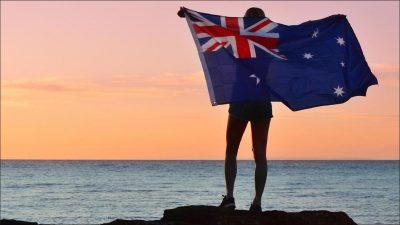
Happy Australia Day cobbers!